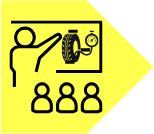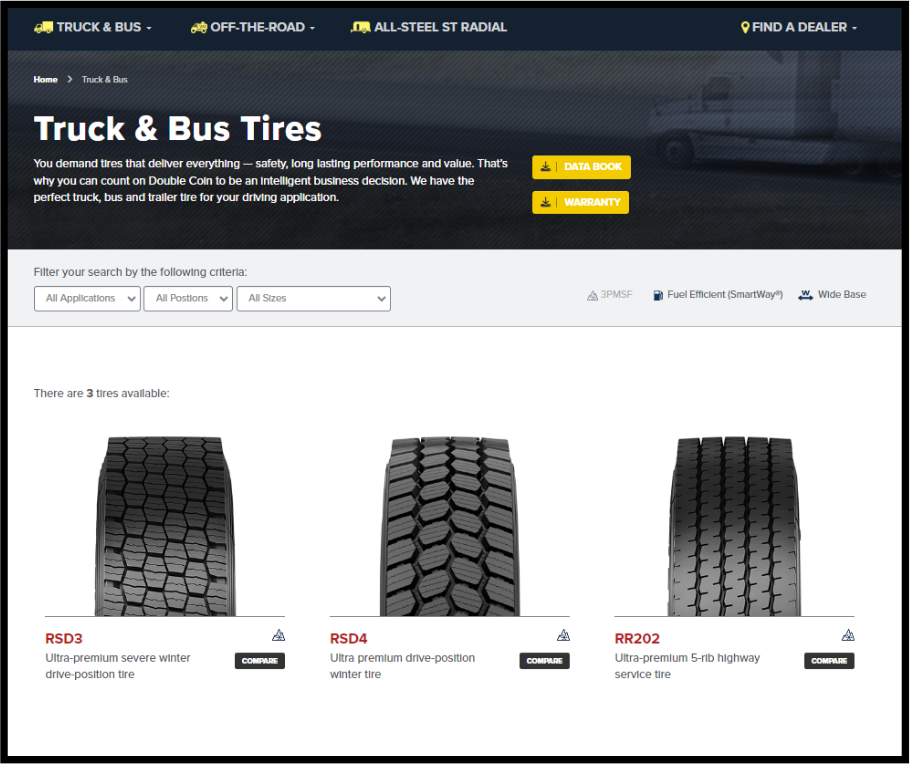
Winter tires are engineered to provide superior traction, handling, and braking in cold weather, snow, and icy conditions. Even the best winter tires will not perform to their full potential without proper care. Following these maintenance practices will help extend the life of your tires, ensure road safety, and avoid unnecessary costs.
 One of the most critical factors in winter tire maintenance is keeping your tires properly inflated. Cold weather significantly impacts tire pressure, causing it to drop by about 1-2 PSI for every 10-degree Fahrenheit decrease.* Under-inflated tires reduce traction and increase stopping distances, making driving hazardous in winter conditions.
One of the most critical factors in winter tire maintenance is keeping your tires properly inflated. Cold weather significantly impacts tire pressure, causing it to drop by about 1-2 PSI for every 10-degree Fahrenheit decrease.* Under-inflated tires reduce traction and increase stopping distances, making driving hazardous in winter conditions.
Check tire pressure first thing in the morning before the tires operate for several hours. Ensure it meets the manufacturer’s specifications to prevent uneven wear and maintain optimal performance.
 Tread depth ensures tires can grip snowy, icy, and wet roads. Driving with low tread increases the risk of hydroplaning and makes navigating winter roads dangerous. A minimum tread depth of 4/32 inches is recommended for steer tires, while all other tires should have at least 2/32 inches of depth.**
Tread depth ensures tires can grip snowy, icy, and wet roads. Driving with low tread increases the risk of hydroplaning and makes navigating winter roads dangerous. A minimum tread depth of 4/32 inches is recommended for steer tires, while all other tires should have at least 2/32 inches of depth.**
Use a tread depth gauge to measure your tires routinely. Never mix tread patterns on dual-wheel vehicles, as this can lead to uneven wear and loss of traction.
 Tire balance and alignment are vital to winter driving safety. Imbalanced or misaligned tires can lead to excessive vibration, reducing control and increasing wear, especially on slick roads. Proper alignment ensures that tires wear evenly and optimally in challenging winter conditions.
Tire balance and alignment are vital to winter driving safety. Imbalanced or misaligned tires can lead to excessive vibration, reducing control and increasing wear, especially on slick roads. Proper alignment ensures that tires wear evenly and optimally in challenging winter conditions.
Schedule regular tire balancing and alignment checks, particularly before winter, to reduce irregular wear and ensure a smooth, safe ride.
 Winter weather affects tires, even when built for cold conditions. Exposure to freezing temperatures for extended periods can make tires brittle, increasing the risk of cracks and damage.** Condensation in the tire valves can freeze, causing air leaks and reducing tire pressure.
Winter weather affects tires, even when built for cold conditions. Exposure to freezing temperatures for extended periods can make tires brittle, increasing the risk of cracks and damage.** Condensation in the tire valves can freeze, causing air leaks and reducing tire pressure.
Regularly inspect your tires for cracks, bulges, or signs of wear, particularly after significant temperature changes. Checking the integrity of the tire valve is essential to prevent pressure loss.
 Inner tires on dual-wheel vehicles often go overlooked but are just as important as outer tires. Failing to monitor them can result in uneven wear, reduced traction, and even tire failure.
Inner tires on dual-wheel vehicles often go overlooked but are just as important as outer tires. Failing to monitor them can result in uneven wear, reduced traction, and even tire failure.
Make inner tire checks a routine part of your pre-trip inspections. Please make sure that both tires on each axle are inflated to the same pressure to avoid excess friction and extend tire life.
 Correctly installing and rotating winter tires is key to their longevity. Always install winter tires as a complete set to ensure uniform performance. Mixing winter tires with all-season or summer tires compromises traction and handling, which can be dangerous in icy or snowy conditions.
Correctly installing and rotating winter tires is key to their longevity. Always install winter tires as a complete set to ensure uniform performance. Mixing winter tires with all-season or summer tires compromises traction and handling, which can be dangerous in icy or snowy conditions.
Follow the manufacturer’s recommendations for tire rotation intervals to promote even wear across all tires. This practice extends tire life and maximizes performance during winter months.***
 When winter ends, proper storage of winter tires is essential for maintaining their integrity for the next season. Tires exposed to heat and sunlight during storage can deteriorate, reducing their effectiveness when needed again.****
When winter ends, proper storage of winter tires is essential for maintaining their integrity for the next season. Tires exposed to heat and sunlight during storage can deteriorate, reducing their effectiveness when needed again.****
Clean your tires thoroughly before storing them in a cool, dry, dark space. Use tire bags to prevent moisture and light from reaching the rubber, and if possible, store them upright to prevent deformation.
 One of the most effective ways to ensure proper tire maintenance is through driver education. Surprisingly, many drivers are unaware of how to properly check tire pressure or monitor tread depth. By training drivers on these tasks, you can prevent accidents and extend the life of your fleet’s tires.
One of the most effective ways to ensure proper tire maintenance is through driver education. Surprisingly, many drivers are unaware of how to properly check tire pressure or monitor tread depth. By training drivers on these tasks, you can prevent accidents and extend the life of your fleet’s tires.
Include tire maintenance training in your regular driver safety meetings. Equip drivers with the tools they need, such as tread depth gauges and pressure monitors, to perform inspections before every trip.
 Maintaining winter tires is not just about keeping your vehicle or fleet operational—it’s about ensuring the safety of your drivers and the public. Proper tire care improves fuel efficiency, extends tire life, and enhances performance in challenging winter conditions.
Maintaining winter tires is not just about keeping your vehicle or fleet operational—it’s about ensuring the safety of your drivers and the public. Proper tire care improves fuel efficiency, extends tire life, and enhances performance in challenging winter conditions.
Following these essential tips will help avoid unexpected breakdowns, reduce costly repairs, and keep your trucks safe and productive throughout the cold season.
Sources
 * Les Schwab: What Should My Tire Pressure Be in Winter?
* Les Schwab: What Should My Tire Pressure Be in Winter?
** Work Truck Online:7 Tips for Winter-Ready Tires
*** Tires-Easy-Truck: Best Winter Tires for Trucks
**** Tire Grades: Where to Store Tires During Winter
The ultra-premium RSD4 drive-position tire is 3 Peak Mountain Snowflake (3PMSF) rated and designed for exceptional grip and control on icy roads; assisting in safer driving in winter conditions. Experience unparalleled traction plus performance for confident driving in harsh weather.

Double Coin tires deliver exceptional value for a wide variety of commercial applications, including trucking, construction, mining, ports and agriculture. Our goal is to provide valuable information for those working in these industries.
Trailer tires that do more than roll—they work. 💼
The Double Coin FT105 delivers:
✔️ SmartWay® fuel savings
✔️ Built for retreads
✔️ Fights irregular wear
Find a dealer near you 👉 https://www.doublecointires.com/dealers/
#DoubleCoin #Fleet #Truck #Tires #highway #trucker #driver #drive #pov…
Twitter feed video.
Looking for long-lasting trailer tires built to handle the miles?
The Double Coin TR100 is ultra-premium, shallow tread, and engineered to wear evenly and eject stones with ease.
Durability. Retreadability. Performance.
🔗 Learn more: https://www.doublecointires.com/tire/tr100
#transpot #trucking…
Twitter feed video.
Looking for long-lasting trailer tires built to handle the miles?
The Double Coin TR100 is ultra-premium, shallow tread, and engineered to wear evenly and eject stones with ease.
Durability. Retreadability. Performance.
🔗 Learn more: https://www.doublecointires.com/tire/tr100
Twitter feed video.
At Double Coin, we take pride in delivering high-quality, reliable, and durable tires that keep our customers moving in the most demanding environments. Hear directly from professionals in the field who trust Double Coin’s REM-2S for their off-the-road (OTR) applications.
📢…
Twitter feed video.
📣 Say hello to serious mileage and long-haul reliability — the Double Coin FD425 is your go-to drive-position tire with a wide tread and the durability to match.
✔️ Ultra-wide footprint = even wear + longer life
✔️ Built to lower fuel costs
✔️ Retreadable and road-tested tough…
Twitter feed video.

Add this ID to the plugin's Hide Specific Tweets setting:


